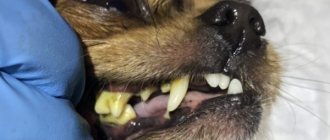If you have a pregnant dog, you've probably started wondering how many puppies will be coming in a few months. After all, you have to start preparing for all those adorable puppies and shopping for items, so it's important to know what to expect.
We'll help you below as we explain the average litter size for dogs, explore some of the reasons why litters vary in size, and share some other interesting facts about dog pregnancy. Let's start!
Gender of puppies
The gender of the puppies is determined only by the male. Each sperm carries an “X” chromosome for a girl or a “Y” chromosome for a boy. The egg is always "X". The sex of the future puppy depends on which sperm gets to the egg first. If “X” is the first to do so, it’s a girl, “Y” is a boy. Spermatozoa “X” are more viable and can “wait”, but “Y” immediately rush to the target and if there are no eggs ready for fertilization, they die. At this time, the “girls” move slowly, they are not in a hurry, their lifespan is 3-4 days. Having reached the goal, they connect with the eggs that have managed to mature. This is how you get “bitch droppings.” If the optimal mating day is chosen correctly and the maximum number of mature eggs is released, the litter will be “male”, or 50/50.
Gender of puppies and diet
There is a lot of debate about the fact that certain feeding habits of a bitch can affect the gender of the puppies. Proponents of this theory argue that if meat predominates in a bitch’s diet, more boys will be born, and if fermented milk products are consumed, more girls will be born. This is justified by the fact that certain products create favorable conditions for the existence of sperm “X” or “Y” in the uterus and fallopian tubes. Everything is individual, there are only general principles and probabilities. It also happens that an underfed stray bitch gives birth to a litter of 10-15 puppies, while a well-groomed domestic one gives birth to only 2-3. If you properly prepare the bitch for mating, provide adequate nutrition and the absence of stressful situations during pregnancy, there is a high probability that a multiple healthy litter will be born!
Optimal headcount results
X-rays are recognized as the most accurate way to determine the size of a dog's litter. X-rays allow you to see the bones of puppies when they are sufficiently hardened and mineralized - approximately 45 days of pregnancy. The doctor can also count the number of skulls, which increases the accuracy of the calculations.
Experienced veterinarians prefer to take x-rays on day 55, since by this time the bones have completely hardened and the calculation becomes more accurate. In addition, one such image will be enough, thus minimizing the radiation exposure of the puppies. Using X-rays, they determine such an important parameter as the location of the embryos in the dog’s uterus. This information will help you have a trouble-free birth.
However, absolute accuracy in calculating the number of puppies today is impossible; any method can produce errors, because puppies, as they grow up, crowd together in a dense heap, and one or two of them may elude detection by the X-ray machine.
Features of pregnancy in a dog
Pregnancy and childbirth in dogs, duration and characteristics, depend on the breed and size of the dog. Large dogs often produce fewer puppies, while small dogs tend to have more puppies in their litters. Litter size can vary from one to fifteen puppies. Puppies can be quite large - this will complicate the birth process and require more strength from the woman in labor and constant attention from the owner.
The owner or breeder must be present at the birth and help accept the puppies. This is the only way he can have a beneficial influence on the course of events. Even weak puppies survive if the birthing process was successful, and active assistance was provided to the babies and mother and proper care was provided. In unfavorable conditions, if the owner is inattentive, negligence is allowed in relation to the mother in labor, and there is a high probability of death of both the mother and the offspring.
The gestation period in dogs, the number of puppies in the litter, and the course of labor may vary depending on the size, breed, and individual characteristics of the animal. Throughout pregnancy, the dog needs careful treatment. The dog should not be picked up or disturbed, often trying to feel the fruits; active walks, jogging and jumping should be limited.
Regardless of how long pregnancy in dogs lasts, throughout the entire period the dog should receive a balanced diet, with the addition of vitamins and mineral supplements. Experts recommend reducing the amount of protein foods 10 days before the expected birth, and in the last week giving up protein altogether. The veterinarian observing the dog must select a suitable diet for the expectant mother - the selection of the diet takes into account the general physiological state of the animal.
Author of the article: Kudryavtsev Vitaly Andreevich
12.04.17
Veterinary blog, For owners
Dear friends!
I am glad to welcome you to the pages of this site! Impromptu agenda today: childbirth in dogs in general and in dogs of dwarf breeds in particular. I would like to immediately make a reservation that there are quite a lot of articles of various kinds, textbooks on this topic, so I will allow myself to limit myself to a thesis statement that is most, in my opinion (as a veterinarian)
, something significant that can really worry an amateur dog breeder and something that should not be forgotten.
So, you and I remember that childbirth (eutocia) is a physiological process, for the sake of which both mating and subsequent pregnancy were started (which, by the way, can normally last from 56 to 72 days). How can we determine that a bitch is already giving birth? That is, in other words, when is it okay to worry? Indirectly, the duration of pregnancy and the approximate day of birth or the number from which you can really start waiting can be calculated by the date of mating, counting about 60-62 days. But this is usually true for bitches who have already given birth, when you know how long the pregnancy lasts for a particular dog. Of course, a necessary addition is visual diagnostics: ultrasound (starting from the 24-28th day of pregnancy) and radiography (from the 45th day of pregnancy). It should be clarified that we can reliably estimate the number of fetuses only by performing an X-ray examination. You can also carry out laboratory diagnostics: look at the level of progesterone (as a rule, it decreases significantly 10-14 hours before birth).
But first of all, you and I will focus on the so-called harbingers of labor or, in simple words, on the clinical signs of impending labor.
Such signs include:
- An increase in the volume of the abdomen as a result of an increase in the size of the pregnant uterus and relaxation of the pelvic ligaments and abdominal muscles. This sign is most relevant for dogs giving birth more than once, as well as for multiple pregnancies.
- Swelling of the mammary glands and swelling of the vulva. Indeed, in most dogs, the mammary glands swell immediately within 24-48 hours, increasing slightly in size. The appearance of colostrum before childbirth is not mandatory: colostrum can begin to be released during labor and after childbirth. Swelling of the vulva can, of course, serve as a sign as such and should only be considered in conjunction with others.
- Decrease in temperature. Stock up on a thermometer (preferably electronic) and, starting from the 60th day, take measurements periodically. It should be recalled that at the end of the 8th to the 9th week the temperature can “jump” within the range of 37.0 (37.5) -38.5°C. Somewhere 12 (rarely earlier) hours before giving birth, the bitches’ temperature “drops” to 37°C on average. Moreover, in large animals it is precisely up to 37°C, but in dwarfs it is up to 35°C.
- The presence or absence of appetite is not a reliable sign.
- Specific behavior in the period before childbirth: building a “nest”, actively digging a “hole”, anxiety. It is not a reliable sign, common to everyone: it very much depends on the conditions of the animal’s keeping, age, characteristics of the animal’s temperament and the level of contact with the owner.
What can be said about the precursors of childbirth is that all factors need to be assessed in a complex manner. And, of course, during the last 2-3 days (that is, starting somewhere from the 59-60th day), if possible, with the dog. In this case, you need to draw your attention while waiting for your dog to give birth to labor disturbances (dystocia). One of the first things you may encounter is abortion. The aborted fetus is very often eaten by a dog. If you are unlucky to encounter this, but lucky enough to discover an aborted fetus in time, then: it would be good to conduct serological studies of the bitch and bacteriological studies of the fetal membranes and stomach contents of the fetuses. If you didn’t see it and the bitch still ate everyone, then there will still be discharge (mucous and/or serous-mucous) and you won’t get any warning signs of labor (since it’s a pathological pregnancy), so the bitch should be examined. By the way, mummified fruits also occur, but rarely, and this happens, you need to be prepared for it.
A common problem is eclampsia-tetany as a result of hypocalcemia. Remember that these pathological processes can develop not only after childbirth, but also immediately before childbirth, in late pregnancy. The situation, as a rule, is typical: on the day, say the 50th, the bitch began to get very worried, it’s hard to breathe shallowly, drooling and tension in the skeletal muscles may also be observed. The cause is most often an unbalanced diet. By the way, an excessive amount of calcium supplements in the diet significantly reduces its absorption in the intestines, which leads to a lack of calcium in the body, because calcium transits through the intestines and is excreted.
Another point that it is better not to forget: if in the last stages the bitch suddenly has a discharge (profuse bloody, bloody-mucous, purulent, of a specific greenish, greenish-brown color) and an unpleasant odor (usually putrefactive) ), then you urgently need to make sure that the fruits are not dead. And if this happens, then urgently remove them from the uterus by a conservative method (ineffective, since with dead and decaying puppies in the uterine cavity, the dog’s body as a whole and the uterus in particular are little susceptible to the action of certain drugs due to increasing intoxication) or surgically. The main causes of intrauterine death of puppies and subsequent discharge are, as a rule, various infections and infestations. But injuries are not the least important. Remember, in later stages the bitch must be protected from injury. A pregnant bitch should, if possible, be kept separately.
Now let's mentally go back a couple of months: in order to understand what and how our pet will be born, it is necessary to at least briefly describe in what sequence and what processes occurred from the moment of fertilization to the actual birth. Fertilization of the eggs is completed in the oviducts, and there the already fertilized eggs pass through the stages of morula and 32-64 cell blastocytes. And then - migration to the uterus. About 16-18 (up to 20) days are allotted for everything. After this, the embryos are allowed a short vacation: no less than 3 days are given to freely swim in a special secretion in the horns of the uterus. Then the embryos must occupy the corresponding areas of the uterus... but the “babies” with a diameter of 2 mm do this very slowly - 3 days. When we talk about the corresponding areas of the uterus, it is assumed that we are talking about the endometrium, in which, a little more than 2 weeks after mating, localized areas of edema appear, located at the same distance from each other: this is for the embryos, so that they are comfortable and they are already attached. Only after their attachment can heartbeats be detected using ultrasound diagnostics. Once attachment is complete, the placenta begins to form. At this stage, the hematomas formed around the embryo form the blood vessels of the umbilical cord. The structural connection of the uterus and fetal membranes, the allantois and the amnion floating in it (containing the embryo) is formed on the 23rd day of pregnancy. So the 35th day comes quietly, and we will already be able to distinguish the bodies of the embryos. On the 40th day, the eyes of the fruit are covered with eyelids, there is fur, claws and even marks are visible. You can also already tell who is who: some are males, some are females. On the 42-45th day you can do an X-ray examination - the skeleton will be visible. And, as it turned out, there are only a little over 2 weeks until the birth.
No matter how experienced the owner of a bitch is, every birth is still an exciting process! No matter what anyone says, everyone is worried! Therefore, during childbirth, it is advisable to provide the bitch with the most comfortable and, above all, calm conditions. Of course, it’s better to give birth to a bitch together! It’s good for one too, but another pair of hands won’t be superfluous for sure. It would be good to take care in advance and have in stock: cream (fat content 22%), honey and coffee. Yes, it would also be good to wash/iron clean rags (and more), a couple of sheets, a couple of waffle towels (or maybe more) and boil some more or less cutting scissors in advance.
Attention! Medications should be administered only (ONLY!) by a veterinarian in accordance with the indications.
Childbirth, as is known, proceeds normally only if the fetus or fetuses are correctly positioned directly in the birth canal of the bitch. By what criteria can one judge whether it is normal/abnormal? So, the first is the position of the fetus: the ratio of the longitudinal axis of the fetal body to the longitudinal axis of the mother's body. There are: longitudinal, transverse and vertical. Naturally, the correct one is longitudinal. Then, the position of the fetus: the relationship of the fetus's back to the walls of the mother's abdomen. There are: top, bottom and side positions, and the top one is correct. Then it is also worth mentioning the presentation of the fetus: the relationship of the anatomical region of the fetus to the entrance to the pelvis. A puppy can “present” with anything: head, pelvis, etc., etc., but it is important for us to remember that cephalic and breech presentations are considered normal. And, finally, the position of the fetus - the position of the head, limbs and tail of the fetus relative to its body - let us immediately make a reservation that much in this matter depends on the presentation: with the head, everything should be in a straightened state, with the pelvic - the head and forelimbs are bent.
Childbirth itself can be divided into 3 stages, with the last 2 being repeated at the birth of each puppy.
The first stage (most often called preparatory) normally lasts from 6 to 12 hours. But it is important to remember that it can easily last all 36 hours, especially such delays are observed in primiparous bitches. But! Don't forget about thermometry, the temperature should remain low. The first stage is characterized by relaxation of the vagina, opening of the cervical canal and strong, but subtle (or unnoticeable) contractions of the uterus (contractions).
Other things to mention: restlessness, shortness of breath, licking of the vulva, possibly defecation and frequent urination. There may even be vomiting. This is normal, no need to worry. Remember, any stranger who comes now is, as a rule, undeniable harm. I want to emphasize two points: everything is proceeding as described (that is, normally) and then a stranger comes - then any visit is harmful! If you see that the dog, although worried, does not show excessive fear, does not howl, there is no profuse bleeding (namely blood), brown or purulent discharge (and at the same time the dog lies like a “rag”, with a temperature below 350C), then keep calm.
So, thanks to the contractions of the uterus, the puppies move further and further towards the pelvic cavity. As soon as the first of them reaches it, more violent contractions of the uterus begin, the abdominal muscles join them (pushing) and the second stage of labor begins, which lasts on average from 3 to 12 hours (rarely it lasts up to 24 hours). How can we additionally determine that the second stage has already begun? Oh, this is interesting: when the fetus enters the birth canal, the chorio-allantoic membrane ruptures, which is accompanied by an abundant flow of clear fluid, that is, the discharge of amniotic fluid. After the water breaks, it can take up to 4 hours for dogs to give birth to their first puppy. Rectal temperature rises to normal. You may not see the proverbial waters, so it is useful to remember that any of the above signs indicate the onset of stage 2. Speaking about pushing, it is appropriate to recall the so-called Ferguson reflex, that is, irritation of the vaginal wall by the presenting parts of the fetus, in response to which pushing appears.
Thus, 5-10 powerful attempts and plus contractions, and the amnion and paws appear, the head and limb girdles erupt, in other words, the fetus is expelled. This is normal, that's all. All about everything in about 5-7 minutes. But you must remember that if the bitch has strong attempts for 20-30 minutes, and no one is born, you will have to consult a doctor, it is unlikely that you will be able to help with anything. Summarizing everything that has been written about the second stage, you should worry in cases where: uncharacteristic, heavy discharge instead of transparent (most likely, labor will be hampered by a dead fetus); the waters broke, 3-4 hours passed, and no one was born; weak attempts for more than 2 hours, but no one wants to be born, or, on the contrary, very strong attempts for more than half an hour with the same result; the first puppy was born, more than two hours passed, and no one else appeared, and palpation (and/or using laboratory diagnostics) reveals more puppies; the second stage itself lasts more than 12 hours.
The first and subsequent puppies are born: don’t wait for anything, break the birth bladder yourself, clean the muzzle of the fetal fluid with a sterile napkin, cut the umbilical cord yourself. As a rule, it is not necessary to apply a ligature to the umbilical cord in small and toy breeds, but in medium and large breeds it will be necessary. In general, it is better to have a clamp for these purposes. It is usually best to cut the umbilical cord at a distance of about 1 cm from the abdominal wall. It would be good, before placing the puppy under the bitch, firstly, wipe it with a hard (preferably waffle) towel (in this way, you seem to imitate the bitch licking the puppy, and this is needed to stimulate the newborn’s blood circulation), and secondly, turn the puppy down head (wrapping it in a towel, otherwise it will slip out), shake it thoroughly a couple of times and noticeably pinch it at the withers (just don’t overdo it too much), so that the baby not only shows all the signs of life, but also screams properly (clearing the upper respiratory tract, if You never know if you swallowed enough amniotic fluid).
If there are more than one puppies, then you have a box or ditch prepared for this case, lined with a clean, ironed sheet with a hot heating pad wrapped in flannel (or something similar). When you have done all the manipulations with the puppy, let the bitch lick it, squeeze out a little colostrum from the nipple and attach the puppy to it. Sucking the bitch's puppies also stimulates the production of colostrum and subsequent labor.
Be sure to count your afterbirth! There should be as many of them as there are puppies. I would not recommend giving them to a bitch to eat: there is still not much benefit from them, but the harm can be significant.
When describing the process of normal childbirth, you should also mention pathological childbirth and your actions in this case. Let me make a reservation right away: in this case, we will consider childbirth—not the pathologies of pregnancy. So, we need to immediately define what we are going to talk about: complicated (pathological, you can find this and that in the literature) childbirth or the inability of a bitch to expel fetuses through the birth canal without outside, preferably medical, help is called dystocia.
It is worth mentioning that, after all, problems with childbirth are not a common problem. According to the British Association of Veterinary Practitioners, in about 5% of 100 you and I may encounter them. Of course, there are also breeds from, so to speak, a risk group - these are brachycephalic breeds, that is, with a large (often not very proportional) head, which theoretically should have difficulties much more often. Dystocia occurs in all breeds without exception, occurs at different ages, and does not always depend on whether the dog has given birth before, and whether its mother and other ancestors had problems with childbirth. But first things first. First, let's check what stage of the birth process is now (?), and has the second stage begun (?), and have we panicked too early? Most often, it turns out that there would be something to make a fuss about... Although we talked about this, let's repeat a few important points: the second stage of labor begins when the waters (amniotic fluid) break, body temperature rises to the physiological norm (measured rectally - that is, using a thermometer inserted into the rectum), pushing began.
So, the main one is the second stage of labor. It would be good to establish the approximate number of fruits by palpation. This is not easy to do. But it is possible. Which means it’s necessary! Having put on a disposable glove (we’ll add it to your list of essentials) and additionally treated with an antiseptic (chlorhexidine bigluconate is perfect - we’ll also add it to the “Must buy!” list), you need to conduct a digital examination of the vagina to see if the cervical canal has fully opened and, if so , is there a puppy in it? Indirectly, the opening of the cervical canal and the activity of the myometrium (muscular layer) of the uterus can be judged by the state of the vagina (or rather by its tone) and the nature of the discharge, but it seems to me that this is all too relative. It is ideal to make sure that everything is fine with the puppies using an ultrasound. Let's make a reservation that on an x-ray we will try to see the accumulation of gases around the fetus/fetuses (the fetus has been dead for more than 6 hours) and the destruction-curvature of the spine and skull (the fetus has been dead for more than 48 hours). We try to detect a heartbeat using an ultrasound. It would also be good to calculate your heart rate (HR): if it is less than 180 beats per minute, then things are bad.
So, you need to run somewhere in cases where (we repeat again): the temperature has risen, but labor has not begun; you saw green discharge, but the puppies were never born; no contractions (more than 2 hours); or no pushing (similar to contractions); both in excess (more than half an hour); general signs of deterioration of the condition (that is, the bitch lies like a rag and stares indifferently “into emptiness”).
So why might labor not begin or... not continue on time? As a rule, most often breeders are faced with weakness of labor. When they talk about weakness of labor, they mean either primary weakness, the causes of which are: obesity of the bitch, a very large litter, a very small litter, very large puppies, poor nutrition; or secondary weakness (its causes are, as a rule, a categorical refusal of the uterus to work for a simple reason: tired). Secondary weakness manifests itself after a fairly rapid onset of labor, but then, then everything stops. Often due to obstruction (complete or partial blockage of the uterus due to improper placement of the fetuses in the birth canal or their death). It is easier to deal with primary weakness; you need to jog/walk the dog - that is, active movements, as well as massage the vaginal vault (that is, imitation of the Ferguson reflex, which I already wrote about).
But if suddenly it doesn’t help, then therapeutic or surgical assistance is necessary to treat primary and secondary weakness.
In addition to birth weakness, a possible cause of problems in a bitch giving birth can be: most often, narrowness of the pelvic canal (very bad when combined with laxity of the abdominal muscles); uterine torsion/rupture; aplasia (absence) and/or hypoplasia (underdevelopment) of the uterine horns (rare); various neoplasias (tumors) and fibroses (overgrowth of connective tissue) are even less common. You can also add prolapse of the uterus under the skin to this, but this can be easily prevented if you check in advance whether the dog has an inguinal hernia (and, if so, then operate in advance). As they say, everything needs to be done on time.
Speaking about the causes of problems during childbirth, we only mentioned the reasons associated with the bitch. “What else can prevent puppies from being born?” - you ask. The answer lies on the surface - the puppies themselves. Firstly (and what is most common), this is the incorrect position of the puppy: this includes breech presentation (normal, but only with the cervical canal completely open) or the so-called breech presentation - also breech, but the hind limbs are bent to the stomach; deviation of the fetal head downwards or to the side (this is a very problematic position of articulation: inserting a finger into the vagina, you find, as a rule, only one front paw - that’s all. Do not pull this paw under any circumstances, you will not pull anything out, the head is turned to the side plus the second paw will get in your way, but the puppy's paw, which you are diligently pulling, will come off and, if not completely, then you will definitely tear off the fingers. You need to, at all costs, turn your head with your finger and pull up the other paw. Once again - for one - don’t pull! If it doesn’t work out and you see that contractions/pushes are actively going on, and the puppy is “standing” and you can’t turn him around - don’t waste time - you need to save him and the unborn (if there are any), so surgical help is necessary in the form of a cesarean section. And if a paw is torn off, then you can try to remove the obstacle in parts. The same manipulations should be undertaken in situations where the fetal front paws are directed backwards or the transverse position of the fetus is “detected” (groped). However, in the case of a transverse situation - very rarely something works out, it is better not to waste time and operate immediately. If two fetuses meet in the birth canal at once, then you need to try to push one away. If he resists and does not push away, then definitely cut!
When correcting the position of the fetus with your second hand, be active: additionally fix the puppy through the rectum (this is especially true for owners of dwarf breeds, where sometimes, not only several fingers, but a little finger cannot be inserted). So, as the puppy passes through the pelvic joint (the perineal region is characteristically bulging), help yourself and the puppy through the rectum. It is important to synchronize your actions with contractions and further stimulate pushing. This is where a third hand comes in handy! You will need an assistant who supports the bitch under the forelimbs with one hand, and massages the abdominal wall with the other hand, thereby stimulating the appearance of more active attempts. You, having fixed the puppy through the wall of the rectum, try to correct its position and position with the finger of your other hand, and as soon as everything is corrected, wait for contractions/efforts, additionally massaging the vaginal vault, trying to fix the puppy with at least something. They pulled it up, secured it and pulled it out.
If the large fruit does not fit through the pelvic joint, we return to the sad thing - cutting again. Often the size of the puppy does not correspond to the diameter of the bitch’s birth canal, because there may also be deformities in the puppy itself. It may already be dead and swollen (with gases in the amniotic sac). May be stillborn and with hydrocephalus. If there is a suspicion of fetal death, it is necessary to cut. And don't wait for anything!
If we happily avoided pathologies and the third stage of labor ended with the expulsion of the placenta (placenta), then it is still too early to relax... Remember that lochia - postpartum discharge containing remnants of the placenta and amniotic fluid, is observed for 3 weeks or more. Lochia is most abundant during the first week and has a greenish tint. But you need to worry if: not all the placenta came out within 4-6 hours after the birth of the last puppy; lochia contains pus and has a putrid odor; the temperature has risen sharply and lasts for a long time (above 39.5°C); heavy bleeding from the vulva (not slightly pinkish spotting, but blood); The bitch's condition deteriorated sharply. Childbirth that lasts more than 24 hours is dangerous for the mother and her puppies!
Hope everything went well for you! If there is still EVERYTHING to come, I sincerely wish you GOOD LUCK! Don't be afraid of anything - everything will be fine!
How many puppies does a dog give birth to for the first time?
Thoughts of the owners
Alexandr Tihomirov
Friends have a pug, and the first birth, and subsequent ones - consistently 8 puppies.
- Fighting dog breeds
- The rarest cat breeds
- German Shepherd
- What kind of snakes are kept at home?
- Ancient dog breeds
- Dog's sense of smell
Oksana Nazarova
The number of puppies does not depend on the time. It all depends on heredity and the correctness of the chosen mating day. From 1 to…. 12 puppies
Miss
The number of puppies in the litter depends directly on whether you get it on the right days of mating, as well as on heredity (multiple or low-fertility female line). Small dogs give birth to from 1 to 5 puppies (chikhi, toy, spitz).
Postpartum care
Here are the steps you need to know for postpartum care, nutrition and care.
Keep your dog on a high calorie diet
Your dog should be on a higher calorie diet (pregnancy or puppy) while she is nursing (nursing puppies). Make sure she always has food and fresh water on hand.
Create a private space for your dog and puppies
Keep the mother dog and her puppies in a clean, quiet, low-traffic area. If there is too much noise around her, she may become nervous and begin to neglect her puppies.
Monitoring puppy feeding
Newborn puppies need to feed from their mother's milk every 1-2 hours, so your dog will likely be with them constantly for the first week or two.
If you think your dog is not producing milk or not allowing puppies to nurse, contact your veterinarian immediately.
Medicines and vaccines should be avoided while your dog is nursing.
Call your veterinarian if your dog seems sick
If your dog is sick, call your veterinarian immediately and let them know she is nursing a baby so they can prescribe safe medications if necessary.
If your dog stops eating, vomits, or becomes very lethargic (weak and tired), or if you notice redness and swelling in any of his mammary glands, contact your veterinarian.
How many puppies can a decorative dog give birth to?
Thoughts of the owners
Chih
Two weeks ago my bitch gave birth to 7 puppies, this is the first time this has happened in the nursery. So far everything is fine, the children are calm, their eyes are open, there is enough milk.
Unknown
In our city, a Yorkie gave birth to 8 puppies. Naturally, not a single girl goes into breeding due to her low weight, but the mother fed all the puppies safely.
Nikolay Repalo
The pug had 8 puppies. Nothing. All are grown. The number of puppies is influenced by the number of eggs ready for fertilization at the time of mating. What prevents you from culling the smallest puppies on the 3rd day?
Henri Cabier
Dogs of different breeds can have from 1 to 20 puppies. Of course, for decorative dogs the usual number of puppies in a litter is 2-6. But sometimes there are unexpected surprises. The number of puppies depends on the matured eggs. In dogs it is much larger than in humans: up to 10–15, sometimes more, eggs are ovulated simultaneously (but not simultaneously), but usually 5–8.
Marina Nazarova
Usually 1-6, but there are exceptions, as in the case you cited.
Ira Gorskaya
My friend's English bulldog gave birth to 10 puppies. They came running from the club and told her to drown 4 - they couldn’t feed her that much. Well, tell me, how can you drown them, they’re alive? Such cool dogs have grown up so cute.
Description of the breed with photos
The German Boxer gives the impression of a strong, hardy dog with well-developed, prominent muscles.
The breed standard stipulates the following characteristics:
- the body is square in shape, with strong bones;
- the head is quite large, but proportional to the body;
- the neck is strong, not too long;
- shortened muzzle with pronounced jowls;
- the eyes are dark and should not be bulging or sunken;
- the nose is large, pigmented black (dark brown is acceptable);
- The triangular ears are set high and close to the muzzle;
- a snack is required;
- limbs are straight, with developed muscles;
- The tail is straight and set high.
Please note: In some countries, ear and tail docking are prohibited by the 2002 German Boxer breed standard.
In addition to the officially recognized German breed variety, cynologists informally distinguish its American type. This includes the descendants of individuals who were transported overseas after the Second World War. They differ from the German ones in their more graceful physique and smaller head size. But these differences are noticeable only to experienced experts.
Indicators such as a head disproportionate to the body (too small or large), open teeth with a closed mouth, an unclear mask on the muzzle, and apathetic movements are recognized as a breed defect.
Size and weight
The German Boxer is a medium-sized dog. According to the standard, height at the withers is:
- 57-64 cm – for males;
- 53-63 cm – for females.
Females are more graceful, their weight rarely reaches 30 kg, ideally females weigh 25-27 kg. Males are more massive; for them, the permissible body weight is set at 27 - 35 kg.
Color and coat type
The coat of the German Boxer is thin, short, with a characteristic shine, and fits tightly to the body.
There are two officially recognized colors: red and brindle, within which many shades are acceptable (from pale yellow to brick brown).
The brindle color suggests the presence of dark, clearly drawn contrasting stripes on the main background. This coat color is the most common; it perfectly emphasizes the dog’s muscular structure.
White spots in a Boxer's color are acceptable, but they should not occupy more than 1/3 of the total surface area of the body. If this ratio is violated, the dog will be disqualified. Sometimes albino puppies are born in a litter, but they are recognized as a breed defect.
How many puppies does a German Shepherd give birth to?
In one litter, a German Shepherd can have from one to twelve puppies. But for one to be born, or twelve, this rarely happens. Most often, a German Shepherd gives birth to 5-6 puppies. In this case, both the puppies and their mother are absolutely healthy after birth. Puppies in this case are born heavier than in larger litters.
To maintain the health of the dog and get good offspring from it, you should not allow more than one mating per year. At the same time, you and your dog will keep healthy and she will be able to feed her puppies without any problems.
Thoughts of the owners
Vili Borisovich
If we are talking about the purity of the breed, then no more than 6 puppies. I'm German. She is already 10 years old and she only brought 6 puppies once. And all other times 2 or 4. If a dog brings 10 puppies no one will buy, for good money and the dog has a minus in the passport. And according to exhibition indicators, the number of puppies must be even. 3 or 5 puppies are not allowed. Therefore, many breeders, in order not to lose money and image, (drown) the extra ones. Well, if you keep a German Shepherd for yourself, then it probably doesn’t matter how many puppies there are. The more the merrier.
moreljuba
A German Shepherd can give birth to a maximum of ten puppies. This amount is the limit for preserving the health of the dog and its offspring. But this is the maximum amount. and in life, a shepherd dog can give birth to one puppy, or two, or three, etc. There have been cases where a shepherd dog had 12 puppies in a litter, but this was a very difficult birth. Moreover, it is believed that it is better to breed a shepherd dog no more than once a year in order to ensure healthier offspring and the health of the dog itself.
Mirra-Mi
The number of puppies in a litter is completely individual for dogs. For the German Shepherd, this range varies from 1 to 10 puppies per birth. The smaller the number of puppies, the greater the likelihood that large, healthy puppies will be born. And it’s better for the dog itself. In order to maintain your dog's health, it is best to breed no more than once a year.
History of the origin of the breed
The German Boxer breed has existed for more than two thousand years. Their ancestors were the now extinct baiting dogs - Bullenbeissers. Their name speaks for itself; translated from German it means “bull biter”. The dogs had powerful jaws with a pincer-like bite. This allowed them to breathe fully while clinging to their prey. Dogs were used in hunting big game: wild boars, deer, bears.
After the ban on the pickling method of extraction, the specialized breed lost its relevance. Its representatives began to be crossed with English bulldogs, and the resulting individuals were used by cattle breeders to protect their herds. Some dog experts believe that German shepherds also participated in the selection process.
The final prototype of the modern boxer was bred in 1850, 45 years later the first exhibition took place in Munich, the establishment of a German boxer fan club, with official recognition of the breed.
Why the new dog received such a name is not known exactly. According to the most common version, it is based on the dog’s ability to use its front paws in a fight. According to other assumptions, the name is based on the appearance of the animal, whose muzzle resembles a boxing glove.
Gradually, active, inquisitive dogs spread throughout the world. In 1950, an international club for boxers appeared - ATIBOX, which included representatives of several dozen countries. Today the breed is very popular in America, but is less common in Russia.
What is the maximum number of puppies for a dachshund?
Thoughts of the owners
Elena-Dara
From the practice of a Veterinarian: the average dachshund litter is from 3 to 5 puppies. The maximum intake was 7. All are alive and healthy, but they started feeding them earlier than the usual litter of 3-4 puppies.
Daiva
When we took ours, there were 9 of them in the litter. The mother killed one herself, the rest were fine. The fee is standard.
Irina Berezovskaya
From one to eight (this is from personal experience)
How many puppies will a Labrador have?
Thoughts of the owners
History of the breed
Expect from 1 to 13 puppies, and I'm not kidding, the number of puppies does not depend on how many times the bitch gave birth, the number of puppies depends on the breeding date
Someone
The number of puppies depends on the number of mature and fertilized (as well as normally developed after fertilization) eggs! The number of puppies does not depend on the number of matings before, not on whether she gave birth or not, nor on the day of estrus (there will either be fertilization or not). And the number can vary from 2-3 to 10-13 puppies.
Childbirth in Yorkshire Terriers
The Yorkieshire Terrier is not a very fertile breed of dog. They usually have 1-2 puppies. It happens less often that 4-5 puppies are born at the same time. There are also known cases of Yorkshire terriers giving birth to 12 puppies at once. If there are a large number of puppies in the litter - 8 or more, it is necessary to ensure that all puppies at least alternately receive portions of mother's milk. Usually you can feed 9 or 10 puppies without any problems, unless the bitch has a problem with milk.
How to properly take part in the process and help the animal
If the birth takes place on time, then there is no need to help the dog. Her body will cope with this task on its own. The only thing you may need to do is:
- Free the puppy from the bubble in which it is born. This is usually done by the bitch, biting the shell and releasing the puppy. But if the birth is the first or prolonged, then the bitch may not perform the required actions. In this case, the puppies are freed from the membrane on their own and, using suction, the airways of the babies are cleared.
- Cut the umbilical cord. An inexperienced female may not know how to bite the umbilical cord or may not want to do it. The owner will have to perform this action himself, using a knife or scissors.
The protruding piece of the umbilical cord is tied with thread (before this, hands and instruments, the thread itself, are disinfected in an alcohol solution), treated with brilliant green or iodine. The necessary things should be at hand, which is why you need to prepare for childbirth.
Helping the dog











